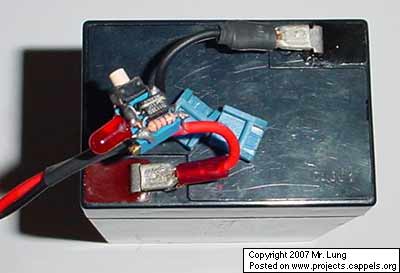The “Battery Good” checker. When the button is pressed,
the green LED will glow if the battery voltage is above the
preset threshold. This version has a higher parts count than
the “Battery Low” version, but a bonus is that it can drive
an LED to be very bright, and the luminance is independent
of the battery voltage. The simple expedient of a jumper wire
on the back of the board made it unnecessary to hold the button
down for this photograph. Besides, my finger is not very photogenic.
Introduction
Mr. Lung wrote to me, asking for some help with a battery checker circuit. After some discussion, we arrived at the the low parts count, high performance “Battery Low” circuit. Mr. Lung prototype it and found it to work to his satisfaction. The “Battery Low” checker lights the red LED if the battery is too low. A second circuit was devised, the “Battery Good” circuit, which lights it green LED when the battery voltage is high enough.
Why two circuits? Because different applications have different needs.
According to Mr. Lung, the lowest safe voltage across a lead acid battery while in long term storage is 2.0 volts per cell, or 6.0 volts for a 6 volt battery. Gates Energy Products, the load must be disconnected from a lead acid cell when the voltage reads 1.8 volts or less, in order to avoid damage. For a 6 volt battery with three cells, this critical voltage is 3 x 1.8 volts = 5.4 volts. Choose your threshold depending upon your application. If there is a good chance that the battery will not be recharged soon after running down, be safe and go with the 2.0 volt per cell threshold.
These circuits can also be adjusted for other battery voltages and other types of battery. This circuit should work well with Nickel Cadmium (ni-cd or nicad), Nickel Metal Hydride (NIMH) or other rechargeable as well as primary cells types such as Carbon-Zinc and Alkaline. Just make sure that you don’t exceed the ratings of the parts for your particular application.
The practical minimum threshold voltage for the Battery Low circuit is about 3.5 volts while the practical minimum voltage for the Battery Good circuit is about 4.5 volts.
As specified by Mr. Lung, this circuit indicates when the battery voltage is too low. His purpose for the checker is to detect when a rechargeable lead acid cell has run down to its safest discharge voltage.
To calibrate this circuit for a 6 volt lead acid cell:
1. Connect the circuit to a power supply set to just above 6.0 volts
2. Hold down the button.
3. Adjust R2 to the point that the LED just comes on.
For more detail: Battery Checker Circuits using microcontroller

